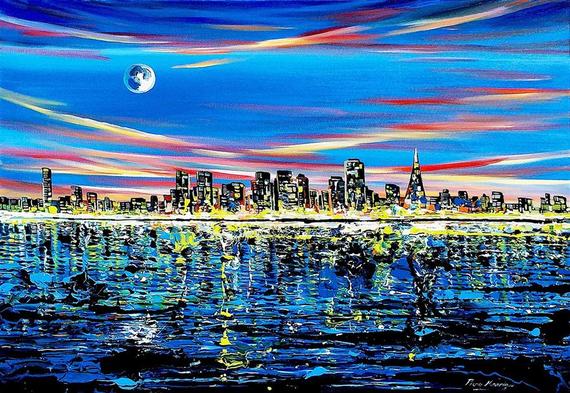Piero Manrique's "San Francisco Night." Still from UGallery.
If you live in San Francisco, you know how much people like to talk about astronomical rents and the resulting disappearance of our city's artful heritage. Local and national news outlets pit the situation as art versus tech, artists forced out into the streets by unwanted progress, a veritable battle of David versus Google. In a city filled with such an incredible mix of thinkers and creators, I can't believe we perpetuate this story.
We are living in a time and place of unprecedented opportunity for artists. It's true that high-paying positions in business and technology companies have partly contributed to huge increases in the cost of living, but these jobs are not pushing out the art scene. In fact, I believe the current landscape of business and innovation in the Bay Area represents the next frontier for artistic development and success.
Generally speaking, the commercial art world has remained unchanged since the inception of the first galleries about 150 years ago. Today, the majority of the market is made up of a fragmented web of local galleries. In addition, a very tiny, exclusive high-end segment of the art world dominates the press. As a result, it takes a lot of time and effort to acquire art, and most people view it as a rarified commodity for the wealthy. For the untold number of artists in the world, landing gallery representation and establishing a career seems about as likely as playing football for the 49ers, thus the starving artist.
Enter technology, the great market equalizer. Like the rise in self-publishing, and the music industry before that, the Internet offers a venue to revolutionize the art world and support many more artists. The next time someone engages you about San Francisco's loss of culture, here are four comments about tech, art and SF that paint a much brighter picture of the future:
1. Art and tech are not in competition with each other. The art market stands at a momentous turning point. Thanks to e-commerce and social media, the old isolated gallery world no longer dictates an artist's success. Online galleries, such as my company UGallery, are promoting many more emerging artists and bringing art to the mainstream by demystifying the buying process. Artists are also connecting directly with buyers through personal websites, marketplaces like Etsy, and social media channels including Facebook, Instagram and Twitter. And content-rich sites like Pinterest and Tumblr lead to viral dissemination of artists' work. Where an artist's reach was traditionally limited by their physical location and ability to garner coveted gallery representation, they now have direct access to a global audience. Plus, as more people have the opportunity to learn about and purchase art, support for local arts will undoubtedly grow.
2. Professional artists must create something people want. Since we're addressing the controversial topic of art and tech, we might as well discuss the longstanding tension between art and commerce. Ever since my idealistic art school days, I've considered the delicate balance between these two realms. In school, the concept of making art to sell is unpopular and typically avoided in conversation. After graduation, however, artists discover that almost all professional artists must create something salable. Being a career artist means making honest, self-expressive work that's also valued by clients. Like any other businessperson in the city, they accept the challenge of living and working here, and creating desirable artifacts. Even as the cost of living continues to climb, many artists thrive. Just ask the 900+ artists who participate in SF Open Studios, the country's oldest and largest open studios program.
3. New wealth will continue to support the arts. Right now, luxury businesses ranging from high-end fashion to designer furniture are popping up across San Francisco. We are witnessing maturing tastes, particularly towards art and design. Art confers power and offers an important form of self-expression for creators and entrepreneurs -- just look at how many of our residents attend Burning Man every year. In addition, local companies including Gap, Airbnb and Google feature art and installations as centerpieces of their office design. For decades, San Francisco has attracted artists and art lovers, and I believe this is an enduring characteristic of the population. As the new money here ages, there will be even more support for Bay Area artists.
4. The gold rush mentality endures (even for artists). San Francisco was built with a pioneering spirit. People have always come here to make change and build wealth, and that includes the art scene. Artists and galleries are trailblazers, continuously leading the way to new areas and fresh ideas, like the recent billboard takeover by The Art City Project. They introduce, gentrify, and move on to the next concept before most people recognize it as popular culture. Why do you think the Mission is so damn cool now? As these neighborhoods transform from old industrial spaces and cheap apartments, we may soon see Bayview as the next hub for cultural revolution.
For the past 10 years, I've envisioned the Internet as the bridge for art to reach the mainstream and dispel the term "starving artist." We are finally nearing that point, and I'm proud (and not surprised) to see San Francisco at the heart of the revolution. This city has always been a magnet for creators, be it artists, entrepreneurs, or engineers. The depiction of tech destroying the arts makes for a good headline, but completely misses the real story of technology assisting artists in building meaningful careers. And let's face it, I don't remember SF ever being an inexpensive place to live.

